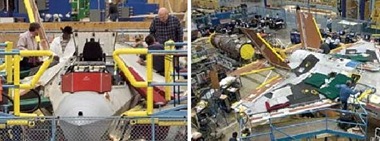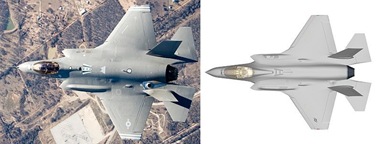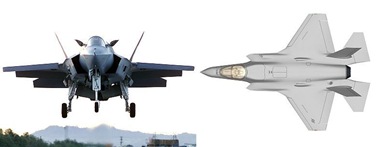The Joint Strike Fighter's press paraphernalia describes the aircraft's manufacturing and assembly in the following manner,
Any great designs are pretty much insignificant unless you successfully manufacture it according to design and are able to use it in accordance with its stated objective. Taking this view, it would not be hard to imagine that one of the major portions of the JSF program is the actual manufacturing of the aircrafts. Manufacturing these aircrafts would require the implementation of concepts and utilization of technology which till now were either never used or even if used definitely not at the scale it would be used here. Some of the noteworthy features seen in the design and manufacture of the F-35 – The Digital trail, Lean manufacturing, Laser positioning system etc.
Manufacturing these beauties poses additional challenges because of the need to source the assemblies and sub-assemblies from contractors from quite literally different parts of the world – from the companies operating in the respective partner countries. Co-ordinating and ensuring standards and compliance among these companies having disparate work culture is no mean feat and the JSF program will have to succeed in achieving it.
Lean manufacturing
In face of ever increasing pressure towards the optimization of the process chain - maximize productivity and minimize overhead expenditure, one concept that has found approval among planners is that of Lean Manufacturing [also referred to simply as Lean].
It essentially is a philosophy, a concept of manufacturing, that seeks to reduce wasteful practices [muda, muri and mura] in the Manufacturing process and helps improve the quality of the finished product [kaizen]. This concept finds its roots in the Toyota Production System [TPS] conceptualized by Sakichi Toyoda [and later formalized to a concrete set of guidelines by Taiichi Ohno] in the aftermath of World War II when scarcity of resources meant that use of available resources were to be optimized to the maximum extent possible. Thus Lean manufacturing addresses two most important aspects of a product – increased quality of the product at a reduced cost - quite often viewed as contradictory end goals.
The guiding principles of Lean Manufacturing are - Perfect first-time quality, Pull processing, Continuous improvement, Waste minimization, Flexibility, Establishing and maintaining a long term relationship with suppliers, Load leveling, Autonomation [smart automation], Production flow and Visual control.
The overall aim of Lean is to eliminate what it refers to as 8 wastes - overproduction, inventory, motion, waiting, defects, transportation, extra processing and underutilized people. These factors result in reduction of the overall quality associated with a product.
A guideline of Lean is to manufacture a product according to demand [pull] rather than any preset manufacturing targets [push]. This is to ensure prevention of over-production and thus its associated excesses.
Lean manufacturing proposes adoption of the Just-In-Time [JIT] concept of manufacturing. In this practice, the raw material needed to manufacture a certain product is made available at the moment production is to commence. There is no stocking of these raw materials for long period before the start of manufacturing. Buffer stock is made available for no more than two or three batches of production [kanban]. In fact, an ideal setup would see responsibility of raw material remaining with the suppliers right till the moment production begins. As a result, inventory, which accounts for a significant portion of expenditure, reduces greatly and consequently its associated costs.
Proper use of scheduling tools like Heijunka box would help reduce the possibility of unevenness in the production's scheduling and ensure a smooth, predictable production plan that is a lot easier to optimize and streamline.
Lean manufacturing is as much about human behavior, culture and their reactions as it is about methods of productions. For a successful implementation of Lean, it is essential that the human workforce is taken on board, convinced and trained [Senpai, Kohai & Sensai] to accept and adopt Lean as a way to improvement.
The Joint Strike Fighter team describes the manufacturing practices adopted for the F-35 as leaner-than-lean manufacturing. However, for all practical purposes, it would be safe to assume that it is Lean Manufacturing philosophy that they have strongly imbued in the F-35.
In in the 90s, Lockheed Martin had embarked upon a program surreptitiously named LM21 to seek and adopt Best Practice that would enable it to achieve Operating Excellence needed to successfully compete in the cut-throat defense market of the 21st century. One of the philosophies they zeroed in on was that of Lean Manufacturing. Though Lean had been in practice in Lockheed Martin earlier too, it had been restricted to small departmental level implementation, the results of which was therefore not optimum.

The first large-scale implementation of this concept was to the manufacture and assembly of the F-16s, which then had been plagued with issues of quality control and delayed delivery schedules. Applying Lean Manufacturing concepts brought about some dramatic results – manufacturing costs reduced by 38%, inventory by 50%, defect rates fell to just 3.4 per plane and delivery time of an aircraft fell from 42 months to 21.5 months. As the assembly line of the F-16s had matured considerably by then, there were limitation of the extent to which changes could be made to it.
So quite naturally, when they won the contract for the design and manufacture of JSF, it would be expected of them to apply these principles to the best possible extent to leverage its benefits from the conceptual stage itself.
Lean principles that guides Lockheed Martin's JSF project include – Transparency, Process focus, instead of just Operation focus, Design for Manufacture and Assembly, Process control, JIT system and Work standardization.
Applying Lean, Lockheed Martin was able to reduce the floor space occupied by the F-16 assembly line by 60%, thus creating space for the manufacture and assembly of the F-35s without expanding [the F-16 line is expected to cease production by 2015, around the time F-35 production would be in full swing]. By applying Lean to the ALE-50 pylon program, Lockheed Martin was able to reduce product travel distance from 200 feet to 50 feet and time for manufacture from 177 hours to 34 hours.
The program is run by a series of Integrated Product Teams [IPTs]. Each team is made completely responsible for one portion of the aircraft. Think of it like a company setup for that one portion of the aircraft. The team is made up of members from the related partner companies for that portion with the head being selected from one of the principle partner companies – Lockheed Martin, Northrop Grumman and BAE. Thus the members think of the project, not just from the point of view of the parent company, but as their own personal project responsibility. However it must not be forgotten that any benefits derived for the portion will in turn be reflected favorably for the partner companies involved.
Problem resolution is done without any delay and at the lowest level possible. In the event of any problems faced by the process [scheduling, cost or process], that phase of the process is halted completely and not allowed to proceed before it as been resolved – even if it means the involvement of the interaction between two or more different IPTs.
Waste reduction and optimization can be seen in the tooling needed to make different but related products. Instead of using separate tools, use of modular flexible tools to perform the same function and also effect a cost saving of 30% on tooling over the traditional way.
Lockheed Martin continuously works with its suppliers of the F-35 JSF to improve and streamline the supply chain. It is done by means of events, training and planning that are regularly organized by Lockheed Martin. It partners with them to analyze and identify opportunities to eliminate waste and through it reduce time and cost and at the same time help them maintain adherence to set standards of the program.
The three variants of the F-35s would be assembled on a single assembly line, which would be able to manufacture either of the variants depending on the requirement of that variant [demonstrating the pull approach of manufacturing encouraged by Lean]. The switchover time for the manufacture of one variant to another is estimated to be less than a day.
Six Sigma principles ensure that defects and errors are reduced to the bare minimum, thus promoting the best-first-time approach, thus saving on costly reworks or even worse, complete scrapping of expensive hardware. Utilizing the concept called the Digital Thread [discussed later], it is possible to access accurate data and information about any product in an easy and convenient manner. This helps improve productivity and increase accuracy of work done, not to mention prevents the generation of costly waste.
The use of advanced machine tool, like Makino 5-axis Model MC1013-5XA Horizontal Machining Center for the machining components of the aircraft ensures accurate high-speed machining process with extreme precision and accuracy. Thus producing a product that is built within tolerance [use of these machines afford the use of extremely close tolerance] and doing away with wastage and scrap. The 5-axis Henri Liné Vertical Machining center for example, can cut at 25.4 m/min at 20000 rpm. Extensive use of automated drilling machines achieves similar ends. The wing assembly is being held vertically to enable better ergonomic work position for the workers, preventing fatigue. Use of precision tools also ensure that sub-assemblies made by the different partner companies mate without the need of re-work at the assembly plant – yet another cost saving factor that is a result of good quality work. [Machining and assembly will be talked about in greater details later]

BAE Systems is known to have invested in upgrading its modular tooling system to manufacture the aft fuselage and the tail of the F-35. It has adopted the use of Metrix advanced coordinate metrology software to design a tool building and inspection process for JSF manufacturing.
Lockheed Martin is paying special attention towards error-proofing the assembly of the F-35. For example, the body of the F-35 is fitted with many panels that cover access holes cut into the body. These panels have been deigned such that a panel fits perfectly only on its designed access hole [Poka-Yoke]. Similarly ink marker robotic arms mounted on gantry-like system sprays identification marks onto assembly components marking its proper location for the assembly process. This prevents and doubts or dis ambiguity about its end utilization.
Using a combination of process changes and advanced machining systems, the JSF team was able to prevent a lot of wastage of resources, which translted to lowering the cost of production. Thus the team has succeeded in manufacturing a 5th generation aircraft that costs around that of a 4th generation one [and according to certain calculations even less than one].












![Secunia Personal Software Inspector [PSI] Secunia Personal Software Inspector [PSI]](https://blogger.googleusercontent.com/img/b/R29vZ2xl/AVvXsEj1BHMQ6Vr5O9UhSSLTuSI0oGhyphenhyphen0BwPojXoyKDjbXIZ5Z22Q6Zmit4bQdEtUyzAvJ3Z7ttigICNR21I-YMqVlqcwsFqIMai3rG61PHXdGAOG9qUx8TqtjQWPztSUjkam2zx_Zi10Q/?imgmax=800)